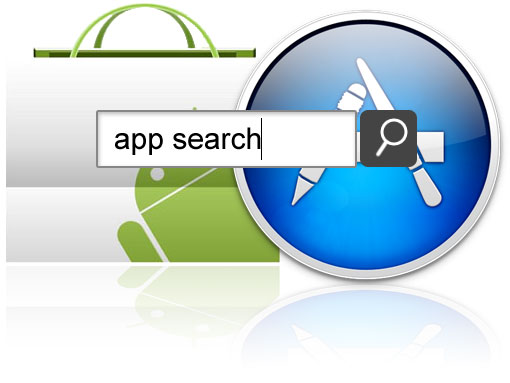
The arena of app stores is much like the way organic search results used to be. Knowledge on app store optimization (ASO) can still provide a big advantage over your competitors and it can be a very lucrative way to exploit your old fashioned SEO skills. Algorithms aren’t as advanced yet and the competition is still discovering ways to game them.
Various App Search Engines
Like in the old days of SEO there are multiple platforms to optimize for, but luckily this time you can do it with separate app versions for each of them. The biggest ones are Apple App Store and Android Market, but Blackberry App World, Samsung Apps Store, Nokia Store, GetJar and Windows Phone Marketplace are just a couple of the alternatives.
All app stores require you to build an app according to their technical and ethical guidelines. Once your app has been added to an app store, you can start to focus on a high ranking.
Growing a huge following for your app is mainly done through social media recommendations, popularity lists on the app stores, and a high ranking within their search engines. In many cases they all lead to each other and you can start with any one of them.
App Store Ranking Factors
The aspects that determine your ranking in an app search engine can be divided in textual aspects, popularity, and rating. While all platforms have their own ranking factor weights and algorithm particularities, the ideal situation of these factors is quite similar.
Textual Ranking Factors
App Name
The name of your app is the most important relevance factor. Besides a catchy name it should include what it does and represent the most important search phrase. “Angry Birds: Puzzle action game!” would be better than just “Angry Birds!” In some engines alphabetical order is also used in lists, so starting with an A or a number might be sensible.
App Publisher
The publisher name can also include keywords and you might even want to publish under several subdivisions of your company. “Badabing Financial Apps” and “Badabing Navigation Systems” would help you rank for those respective search terms.
Keywords and Description
Keyword rich descriptions work similar to normal SEO text, but because install popularity is a huge ranking factor you could also include existing popular themes (popular app names, popular people, news hypes and more) that you could also rank for. Great text, screenshots, app icon and instruction videos in the description all need to get people to install your app.
Popularity Ranking Factors
The most important ranking factor for most app platforms is based on install trending and install base.
Installs so far
The amount of machines that have installed your app so far is logged and shown by almost all platforms. A huge amount of installs provides you a higher ranking and evokes trust for additional installs.
If the number of installs was the only factor, then the big would keep getting better and newcomers would never stand a chance. Luckily, newcomers can benefit from install trends that are also monitored and used by most app stores.
Install Growth Spikes
When you receive a lot of new installs in a short timeframe you end up in both generic and categorized popularity lists. It also helps you to rank for the keywords in your app description and reviews.
Most app stores use the amounts you grow and the previous week is more important than the previous month. Because this isn’t always fair to newcomers, some stores also use the percentages you grow and the steady growth you show over time.
Current Installs, Uninstalls, Active Installs
To combat manipulation it’s much smarter to look at current install base instead of the amount of people that once installed the app. App stores that are able to monitor this can see how satisfied people are with your app and how many people uninstall it.
Some experiments on app store algorithms show which platforms conclude a big drop in ranking after a big drop in installs. Only a few platforms seem to look at active installs. If a machine never requests update availability or communicates with a server they can also be seen as inactive.
Ratings and Reviews as Ranking Factor
Ratings and reviews are available in most app stores, but there is a huge difference in their affect on your ranking. Just a few of them use the review text to answer a keyword search in their search engine.
A test with near unique phrases shows which platforms use it. Ratings are used by most stores to aid or ruin your ranking, but all in varying strength. Android Market also uses Google Plus endorsements and “mark as inappropriate” opinions.
Special Lists
Take a good look at the additional lists that each app store seems to show and figure out what their respective ranking determination is. “Users also installed” and “Users also viewed” might not seem that easy to influence, but ranking for related keywords are a great start. “Editor’s choice” is still something hard to manipulate, but we’re slowly discovering ways for all of them.
Lucrative?
Mobile business models are already great, volume is enormous, customers are loyal, and app store competition is still relatively low. This new frontier holds great opportunities for people familiar with all aspects of SEO and social media. Let the battle begin!
